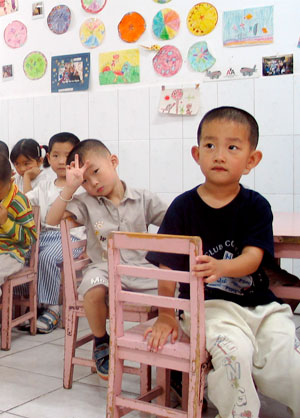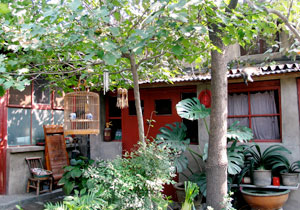BEIJING - This is a city that changes in the blink of an eye, literally. As an old building disappears in a cloud of demolition dust, a new one appears when the dust clears.
That’s what this ancient city experienced in the last several years as it rushed to change its looks in time for the 2008 Summer Olympic Games and catch up to the rest of the modern world.
In some cases, Beijing has passed the rest of the world now – and the world has been beating a path to China’s doors in recent years to see what it has to offer.
The stampede from the West has been nothing short of amazing and in just a few short years the country, and especially its capital Beijing, have been totally transformed.
Which saddens tour guides like Thomas Wong, who fear the “old Beijing” tourists really want to see will be lost to the wrecker’s ball forever as the city modernizes and expands to accommodate the thousands of migrant workers who move to the capital each year.
Oh, sure, Tiananmen Square, the largest public square in the world, and the Forbidden City will always be here – protected by national decree.
“But I fear the inner city, where homes that date back hundreds of years and really tell the history of Beijing, won’t be here, at least not as prominent as they once where,” reported Wong.
The homes Wong talked about are the hutongs that were first constructed 800 years ago during the Yuan Dynasty. Before the Beijing facelift began, there were hundreds of the homes gathered on the backstreets of the capital – where the working class lives - and they were as much a tourist draw as the Forbidden City. In fact, many sat in the shadow of the great palace. So many began to fall victim of the wrecker’s ball, however, historians around the world cried foul and the Chinese government stopped demolishing them. However, that was after almost all were destroyed – just a few hundred remain. The irony now is the few hutongs left have been bought by rich foreign business people and transformed into million dollar modern homes – only the façade remains intact or refurbished to its original state, protected by the central government. But the ones still owned by Beijing families have become wonderful tourist attractions.
“Would you like to see one?” asked Wong.
The offer was too tempting to resist. Soon we were traveling through the back streets on a bicycle rickshaw called a pedicab, passing people squatting in the entrance of their shops enjoying a cigarette and old men pulling their wares on wooden carts, themselves relics of the past.
We were headed to a hutong where an old married couple live and subsidize their meager government pensions by welcoming foreigners into their garden home. Tour operators pay the couple the equivalent of $40 a visit, still a huge amount of money for inner city residents.
The Willow Shade district where the remaining hutongs are clustered together is one of the most beautiful in the city – filled with a large lake, oak lined streets, small outdoor cafes and some awesome parks.
Thomas Wong told me to wait as we arrived at the entrance of a long alley and he ran off in the direction of an old wooden gate down the lane.From a distance, I could see Wong and a round-faced woman talking – she was smiling brightly. Wong returned and told me: “Zhu Xiu Hui (the woman) is ready to welcome us to her courtyard home (known as a siheyuan).” The elderly woman who looked much younger than her age, could not speak English but motioned us inside the modest home she shared with her husband Wen Yong.
Zhu Xiu Hui’s home is 200 years old and in places shows the ware and tear of time. The small open courtyard where the family lives during Beijing’s warmer months was filled with plants, barking dogs and a bird cage.
Through our interpreter Wong, Zhu Xiu Hui apologized for the fact her husband was not there to greet us. “He is shy and does not feel comfortable around strangers – but I do,” said an ever smiling Zhu Xiu Hui, who waved us over to her prize possession, a chirping canary.
“My bird makes beautiful music” said the delightful woman.
“She would like to have some tea with her,” said Wong who quickly translated out eagerness to share some quality time with the woman.
While Zhu Xiu Hui prepared the tea and some cherry cakes in her open kitchen, it gave us time to explore the small home constructed of heavy timber, carved stone and lots of hand carved wood decorations.
Over black tea, Zhu Xiu Hui told me her father bought the home for the equivalent of a few thousand dollars over 70 years ago and she brought her family up in the one bedroom house featuring a living room/dining room and small cupboard-like kitchen.
All of Zhu Xiu Hui’s prized lifetime mementoes were stacked on a few shelves in the living room. I asked if she ever thought of selling the house, which could make her an instant millionaire.
“A million dollars can never replace the millions of memories that are carved into the walls of this home,” said Zhu Xiu Hui through Wong. “I am an old lady – my husband is even older. What would we do with money. I will pass this home to my eldest son and the family legacy will continue.”
Then Zhu Xiu Hui told me she did this, welcoming strangers, not for the money, but to meet people from different countries. “She tells me she likes North Americans best because you are all so wealthy and dress so nice,” said Wong as Zhu Xiu Hui nodded.
Our time with Zhu Xiu Hui passed quickly and after tea and cakes Wong pointed to his watch and told us the pedicab tour – offered by just a few tour operators – must continue.
“There is much more to see and we don’t want to miss visiting the school around the corner.”
I put out my hand to say goodbye to Zhu Xiu Hui but she opened her arms and offered a loving hug. As we walked back to the pedicab, Zhu Xiu Hui kept waving at me until the pedicab pulled out of sight.
I didn’t think anything could top the hutong visit until we pulled up in front of an elementary school where a large group of tourists were holding hands and singing with some tiny pre-school tots.
“These children make me miss my grand kids so much,” said a visiting woman from Wyoming. “They are so cute, so polite.” Again, many tour operators include this stop in their itineraries so tourists can get to know the real Beijing, which seems a world away from the hustle and bustle of downtown.

 Above: Local school kids near Beijing's hutongs like to invite foreigners into their classrooms.
Above: Local school kids near Beijing's hutongs like to invite foreigners into their classrooms.
English is taught to children even before they enter elementary school in China and teachers like to have students interact with English visitors. Hello seemed to be the word of the day and every one of the small children greeted us with “hello”, and some included “mister” in their greeting.
Back on the pedicab, the driver took us around a man-made lake called Shi Cha Hai, whose shoreline laps the streets in this area. The lake was made to join downtown Beijing with the ancient Summer Palace and cruises are still operated to and from this area.
An area known as Di An Men Yen Dai Xie Jie, or Pipe Street, is a place tourists love to stroll, amid busy streets dominated by little grocery shops and the odd smoking shop, where pipes have been made for centuries. The buildings in this area date back hundreds of years and the facades are covered in wood carvings depicting the 12 animal signs that make up the Chinese lunar calendar.
It was time for us to return to our modern hotel and on the return trip we passed Zhu Xiu Hui’s courtyard home, where she was welcoming another group of Westerners and opening a door to China’s past.